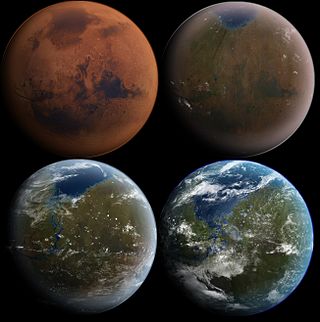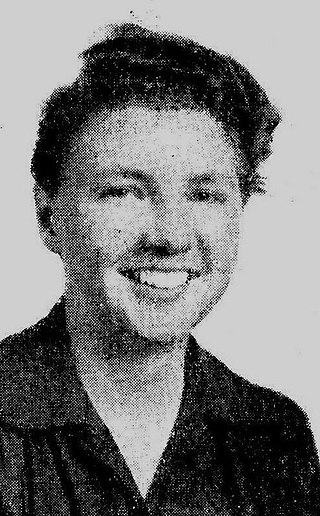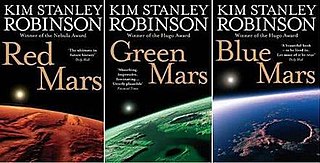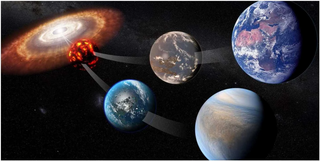
Mars, the fourth planet from the Sun, has appeared as a setting in works of fiction since at least the mid-1600s. Trends in the planet's portrayal have largely been influenced by advances in planetary science. It became the most popular celestial object in fiction in the late 1800s when it became clear that there was no life on the Moon. The predominant genre depicting Mars at the time was utopian fiction. Around the same time, the mistaken belief that there are canals on Mars emerged and made its way into fiction, popularized by Percival Lowell's speculations of an ancient civilization having constructed them. The War of the Worlds, H. G. Wells's novel about an alien invasion of Earth by sinister Martians, was published in 1897 and went on to have a major influence on the science fiction genre.

Terraforming or terraformation ("Earth-shaping") is the hypothetical process of deliberately modifying the atmosphere, temperature, surface topography or ecology of a planet, moon, or other body to be similar to the environment of Earth to make it habitable for humans to live on.

Leigh Douglass Brackett was an American science fiction writer known as "the Queen of Space Opera." She was also a screenwriter, known for The Big Sleep (1946), Rio Bravo (1959), and The Long Goodbye (1973). She also worked on an early draft of The Empire Strikes Back (1980), elements of which remained in the film; she died before it went into production. In 1956, her book The Long Tomorrow made her the first woman ever shortlisted for the Hugo Award for Best Novel, and, along with C. L. Moore, one of the first two women ever nominated for a Hugo Award. In 2020, she won a Retro Hugo for her novel The Nemesis From Terra, originally published as "Shadow Over Mars".

Double Star is a science fiction novel by American writer Robert A. Heinlein, first serialized in Astounding Science Fiction and published in hardcover the same year. It received the 1956 Hugo Award for Best Novel.

The Mars trilogy is a series of science fiction novels by Kim Stanley Robinson that chronicles the settlement and terraforming of the planet Mars through the personal and detailed viewpoints of a wide variety of characters spanning almost two centuries. Ultimately more utopian than dystopian, the story focuses on egalitarian, sociological, and scientific advances made on Mars, while Earth suffers from overpopulation and ecological disaster.

Moving Mars is a science fiction novel written by Greg Bear. Published in 1993, it won the 1994 Nebula Award for Best Novel, and was also nominated for the 1994 Hugo, Locus, and John W. Campbell Memorial Awards, each in the same category. The main focus of Moving Mars is the coming of age and development of Casseia Majumdar, the narrator, as political tensions over revolutionary scientific discoveries build between Earth and Martian factions, and Mars tries to unify itself.
Planetary engineering is the development and application of technology for the purpose of influencing the environment of a planet. Planetary engineering encompasses a variety of methods such as terraforming, seeding, and geoengineering.

The planet Venus has been used as a setting in fiction since before the 19th century. Its impenetrable cloud cover gave science fiction writers free rein to speculate on conditions at its surface—a "cosmic Rorschach test", in the words of science fiction author Stephen L. Gillett. The planet was often depicted as warmer than Earth but still habitable by humans. Depictions of Venus as a lush, verdant paradise, an oceanic planet, or fetid swampland, often inhabited by dinosaur-like beasts or other monsters, became common in early pulp science fiction, particularly between the 1930s and 1950s. Some other stories portrayed it as a desert, or invented more exotic settings. The absence of a common vision resulted in Venus not developing a coherent fictional mythology, in contrast to the image of Mars in fiction.

Colonization or settlement of Mars is the theoretical human migration and long-term human establishment of Mars. The prospect has garnered interest from public space agencies and private corporations and has been extensively explored in science fiction writing, film, and art.
Terraforming is well represented in contemporary literature, usually in the form of science fiction, as well as in popular culture. While many stories involving interstellar travel feature planets already suited to habitation by humans and supporting their own indigenous life, some authors prefer to address the unlikeliness of such a concept by instead detailing the means by which humans have converted inhospitable worlds to ones capable of supporting life through artificial means.

The terraforming of Mars or the terraformation of Mars is a hypothetical procedure that would consist of a planetary engineering project or concurrent projects, with the goal to transform Mars from a planet hostile to terrestrial life to one that can sustainably host humans and other lifeforms free of protection or mediation. The process would involve the modification of the planet's extant climate, atmosphere, and surface through a variety of resource-intensive initiatives, and the installation of a novel ecological system or systems.
A flag of Mars is a concept of a possible flag design, meant to symbolize the planet Mars or to represent a fictional Martian government, in works of fiction.
The ethics of terraforming has constituted a philosophical debate within biology, ecology, and environmental ethics as to whether terraforming other worlds is an ethical endeavor.

Axis is a science fiction novel by American-Canadian writer Robert Charles Wilson, published in 2007. It is a direct sequel to Wilson's Hugo Award-winning Spin, published two years earlier. The novel was a finalist for the 2008 John W. Campbell Award.

An Earth analog, also called an Earth analogue, Earth twin, or second Earth, is a planet or moon with environmental conditions similar to those found on Earth. The term Earth-like planet is also used, but this term may refer to any terrestrial planet.

The Martian is a 2011 science fiction debut novel written by Andy Weir. The book was originally self-published on Weir's blog, in a serialized format. In 2014, the book was re-released after Crown Publishing Group purchased the exclusive publishing rights. The story follows an American astronaut, Mark Watney, as he becomes stranded alone on Mars in 2035 and must improvise in order to survive.

Old Mars is a "retro Mars science fiction"-themed anthology edited by George R. R. Martin and Gardner Dozois, published on October 8, 2013. According to the publisher Tor Books, the collection celebrates the "Golden Age of Science Fiction", an era before advanced astronomy and space exploration told us what we currently know about the Solar System, when "of all the planets orbiting that G-class star we call the Sun, none was so steeped in an aura of romantic decadence, thrilling mystery, and gung-ho adventure as Mars." Old Mars won a 2014 Locus Award.
The Expanse is an American science fiction television series developed by Mark Fergus and Hawk Ostby for the Syfy network, and is based on the series of novels of the same name by James S. A. Corey. The series is set in a future where humanity has colonized the Solar System. It follows a disparate band of protagonists—United Nations Security Council member Chrisjen Avasarala, police detective Josephus Miller, ship's officer James Holden and his crew—as they unwittingly unravel and place themselves at the center of a conspiracy that threatens the system's fragile state of cold war, while dealing with existential crises brought forth by newly discovered alien technology.
The Expanse is a series of science fiction novels by James S. A. Corey, the joint pen name of authors Daniel Abraham and Ty Franck. The first novel, Leviathan Wakes, was nominated for the Hugo Award for Best Novel in 2012. The complete series was nominated for the Hugo Award for Best Series in 2017. It later won, following its second nomination for the same award in 2020.












